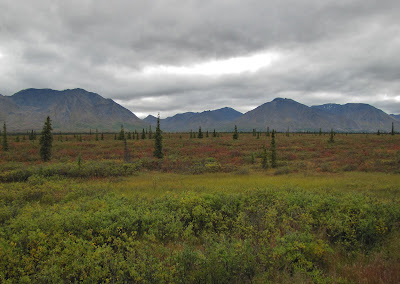Day 7
THE KENAI PENINSULA
A stop off at the Alaska Wildlife Conservation Centre and a sightseeing trip into Aialik Bay from Seward.
We journied south east from Anchorage along the Seward Highway to the head of the fjord called Turnagain Arm. The early morning fog that hung over the water was just clearing and elements of the "Drowned Forest" with ghostly, bleached dead trees provided a reminder of the 1964 earthquake when the land dropped 4ft and the sea rushed in. Here at the entrance to the Kenai Peninsula lies the Alaska Wildlife Conservation Centre with its selection of rescued and bred animals like this grizzly bear having an early morning nap.
This is a non-profit making organisation dedicated to conservation and education. Where possible rescued animals are later released. The grizzly bear above was badly crippled by porcupine quills when found.
Below one of two Kodiak brown bear cubs that had been orphaned on Kodiak Island.
Each animal had its own story to tell but some were being bred in order to increase numbers in the wild like these musk ox.
We also saw caribou
and moose
among other animals and then it was time to journey further south on the highway to Seward. From Seward we took a sightseeing cruise by jet boat through Resurrection Bay and into Aialik Bay. Near the entrance to Resurrection Bay we passed Bear Glacier
and then as we cruised to the head of Aialik Bay we passed Pedersen Glacier the snout of which hides behind a chain of low lying morrainic debris forming rocky islands.
The Harding Icefield is 70 miles long and 30 miles wide and covers the Kenai Mountains to the north and west of the fjord. One of its most spectacular glaciers is Aialik Glacier
which lies at the head of the fjord
Returning past the Chiswell Islands, lonely rocky outcrops at the threshold to the bay, we spotted a rookery of Steller Sea Lions
but so too had a group of passing killer whales.
Back in the sheltered waters of Resurrection Bay sea otters were taking time out to relax.
Soon it was time to end the land part of our trip and as we returned towards Seward we could see our cruise ship waiting for us at the quayside.





























































